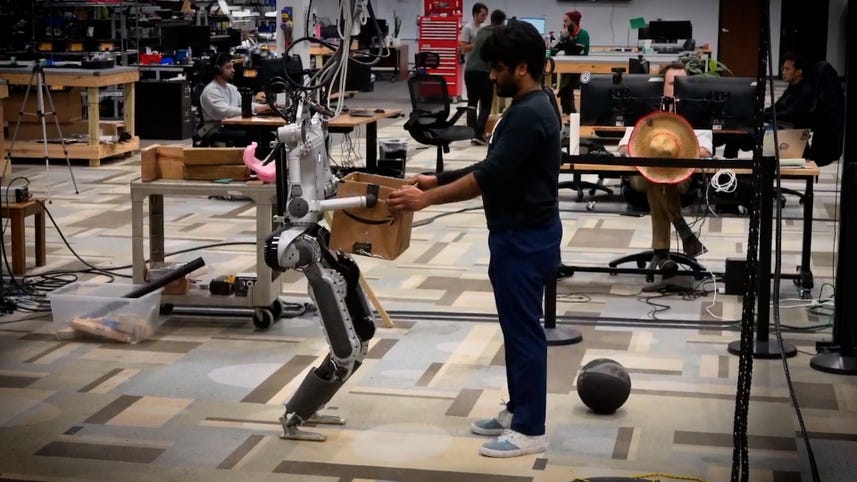
Speaker 1: This robot was built in less than four months and it helped engineers design what we expect to be one of the first general purpose humanoid robots that you can buy. This is Q D H or quick development humanoid from Startup appro. Just watch how we can navigate all these obstacles on the ground. It's no pushover either.
Speaker 2: [00:00:30] The type of walking that we do is called dynamic walking. Really what that means just for the general public is walking like a human walking dynamically, dynamically balancing.
Speaker 1: That's Eltron. C E O, Jeff Cardenas. He says they developed Q D H for a much bigger project.
Speaker 2: What QD H is really showing off is this idea of dynamic walking a functional system and the things that we learned from that are now informing the design [00:01:00] for the Apollo system.
Speaker 1: Apollo is a general purpose humanoid robot that Tron has partnered with NASA to develop. No, it's not going to space anytime soon, but NASA does want to encourage the development of humanoid robots that could eventually help on future space missions. Now, we can't show you what Apollo actually looks like because Tron hasn't actually shown to the public yet. So here's what we do know. It stands about five foot eight, about the size of an average human, weighs about 160 pounds [00:01:30] and it can lift about 55 pounds. Also, it's a general purpose humanoid robot. So what does that mean exactly? We see robots all the time that are designed to do a specific task like move boxes or make a pizza. What we have yet to really see is a robot that can do a lot of different things.
Speaker 2: We think about it like the iPhone of robots, one hardware platform, and now you can use software to update what that hardware platform can do and the applications [00:02:00] become limitless. And the reason for a humanoid robot is that we've designed the whole world for the human form. All of our built environment is designed for the human form. And so you don't want to change the environment around what the robot can do. You want the robot to fit into the human world.
Speaker 1: Of course, Tron isn't the only company working on a humanoid robot. The most obvious other examples being Boston Dynamics with its Atlas Robot and Tesla's optimist, which was revealed for the first time [00:02:30] late last year. Now, Apollo's Roots go back to app's. First robot called Astra
Speaker 2: Astra was really showing this idea of versatile manipulation. And in the video that's what you're seeing as you're seeing it grab a variety of different objects, uh, that it hasn't seen before. The way that we're controlling that system is via Teleoperation, so there's actually someone behind the scenes that is remotely controlling that robot. And we're really just demonstrating the versatility of a [00:03:00] single platform to do a whole wide range of things.
Speaker 1: And it's worth noting that several companies right now are testing Astra for various use cases. So the big question is when are we actually gonna see Apollo? Well, Jeff told me that Appic plans to show it to a small group of people at South by Southwest next month. The rest of us are gonna have to wait until later this year. Now you might be wondering how much is Apollo actually gonna cost? APPR says they're hoping to keep that price under a hundred [00:03:30] thousand dollars. Now that would be really impressive, pretty affordable for a general purpose humanoid robot like that. So we're just gonna have to wait and see if they can pull that off. But what do you think? How do you think it will compare to other robots like Atlas and Tesla's optimist? Let me know when those comments down below. If you enjoy this video, don't forget to give it a thumbs up and subscribe to CNET for more what the future.